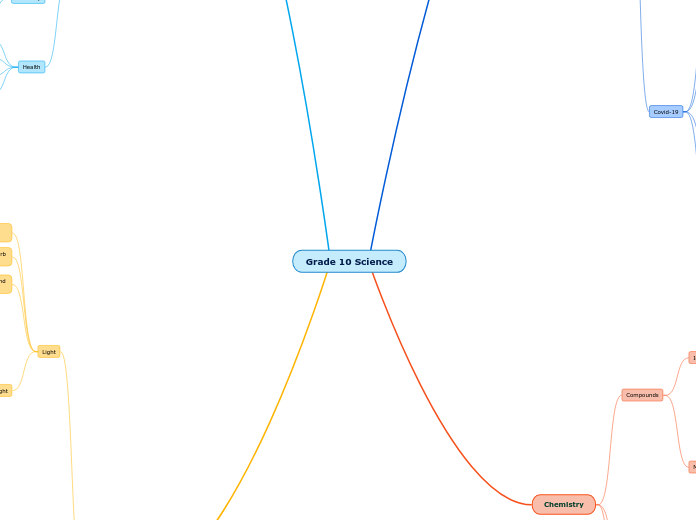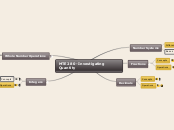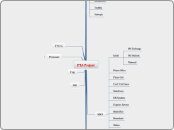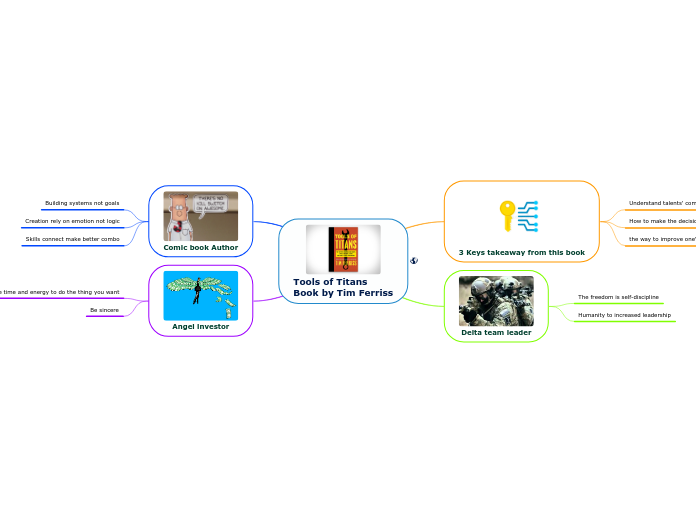Grade 10 Science
Optics
Refraction
The difference in the speed of light in different objects is called the Index of Refraction
It happens because the speed of light it different in different objects
When light bends after passing through an object at an angle
Lenses
Light refracts towards a focal point
Makes light rays converge
() shape
Subtopic
Makes light rays diverge
)( shape
Mirrors
Convex
Makes image smaller
Diverges light rays
Bulges out
Concave
Makes image bigger
Converges light rays
Scoops in
Plane/Flat Mirrors
Angle of incidence is the same
as the angle of reflection
Colour Theory
Subtractive
CMY mixed together makes black
Primary colours are CMY,
Secondary colors are RGB
Taking away light to make colours
Additive
RGB mixed together makes white light
Primary Colours are RGB,
Secondary colours are CMY
Adding light to make colours
Light
Sources of light
Most things are not luminous
Objects that produce light are luminous
Triboluminescence (light is produced
when an object is moved or scratched)
Electron Discharge (an electric current
passes through the air or a gas)
Chemiluminescence (light produced by a chemical reaction)
Phosphorescence (chemicals
create glow in the dark paint)
LED (electricity flows through
a semiconductor which releases light)
Fluorescence (chemicals absorb UV
energy and change it into light)
Incandescence (light from heat)
Each type of light has a different wavelength and
belongs on the electromagnetic spectrum
Radiowaves, microwaves, infrared rays, human vision, UV rays, x-rays, gamma rays (radiowaves have the longest wavelength and gamma rays have the shortest)
Human vision is the only light that we can see
Red, orange, yellow, green, blue indigo, violet
Can either refract, reflect, or absorb
into a medium when it hits it
A wave of energy that can travel through different mediums (transparent, translucent, opaque)
Climate Change
Effects
Health
Floods and other extreme weather events can cause injuries
Higher temperatures could lead to new diseases
Bad for mental health
Inhaling polluted air can cause respiratory issues
Economy
Can affect the availability of resources
Winter tourism will suffer
Effects of climate change damage things
we use everyday (power, roads, buildings, etc)
Environment
Rising ocean levels
Increased temperatures
Ocean acidification
Melting glaciers and permafrost
Biodiversity
Phenological mismatches
Habitat destruction
Combustion
This is bad because it puts excess
carbon dioxide into the atmosphere
Used in gasoline cars, furnaces, and stoves
A reaction that produces oxides
Sources and Sinks
Sink
Something that takes out a greenhouse
gas from the atmosphere and
stores it (ex. plant, ice, water)
Source
Something that contains and releases a
greenhouse gas into the atmosphere
(ex. vehicles, factory, volcano)
Greenhouse Effect
Anthropogenic (caused by humans)
Humans are bad for the planet 👍
Earth naturally keeps greenhouse gases in check
but humans are increasing the amount and it's
hard for the Earth to keep up
Natural
Water vapour, caron dioxide, methane, and nitrous oxides are greenhouse gases.Greenhouse gases are good unless they're excessive
Earth's natural way to stay warm. The amount of gases in the atmosphere are usually just enough to regulate climate
Earth's Spheres (receive the sun’s energy, traps, stores,
and moves it around until it all radiates back into space)
Biosphere - all plants, animals, bacteria, etc
Lithosphere - the Earth's crust (solid rock, soil, minerals)
Hydrosphere - liquid, water vapour, and ice
Atmosphere - gases surrounding the Earth
Weather vs Climate
Weather is more short term and specific to a town/city whereas Climate is more long term and encapsulates the Earth as a whole
Chemistry
Acids and Bases
Food items are usually Acids,
Cleaners are usually Bases
Acids contain non-metals
Bases contain metals
Corrosive, Conduct Electricity,
Dissolve in Water
pH Scale
Determines how strong or
the acid or base is
Reactions
6 Hints: New colour, new odour,
sound, emits light/flame/gas,
difficult to reverse, forms precipitate
Synthesis, Decompostition,
Single Displacement,
Double Displacement,
Combustion, Neutralization
Reactants combine to make a product
Law of Conservation of Mass
Balancing equations so both sides are equal
In a chemical reaction matter
cannot be created or destroyed
Compounds
Molecular
Prefixes
ex. triphosphorus disulphide
Covalent Bond
Share electrons to become stable
Diatomic Molecules
All the 'gens' and the Halogens
Non-Metal and Non-Metal
Ionic
Suffixes
'ide'
Non-Metal and Metal
Polyatomic
'ite' or 'ate'
Multiple elements join together
to act like an ion
Multivalent
Charge is represented in Roman Numerals
More than one ionic charge
Anion or Cation
Positive or Negative charge
Biology
Covid-19
The reason I'm doing this
assignment at home
Characteristics
Very contagious and
contagious for a long time
Takes a while for symptoms
to appear (2 weeks)
Very serious
Spreads easily
Kills a lot of people
Affects the lymphatic, respiratory,
muscular, and digestive system
Vomiting or diarrhea (Digestive)
Muscle or body aches (Muscular)
Fever or chills (Lymphatic)
Cough, shortness of breath, and
difficulty breathing (Respiratory)
ACE-2 receptors are how it gets into cells
Organ Systems
Shoots
In charge of transpiration
Above ground (stem, leaves, flowers, and fruit),
pulls water through vascular tissue
Roots
Below ground, take up water and
nutrients and send them to the stem
Lymphatic
Can gives you a fever, or make you
swell up as an immune response
White Blood Cells (Leukocytes)
Lymphocytes destroy bad
things by creating antibodies
Phagocytes trigger a response
by alerting lymphocytes
Makes sure you don't get sick
Digestive
We need nutrients and energy from
food to survive so this is important
4 Stages: Ingestion, Digestion,
Absorption, Egestion
Esophagus, Stomach, Intestines, Rectum
In charge of digesting food and
absorbing nutrients
Respiratory
Breathing is involuntary and
controlled by the brain
Trachea, Lungs, Bronchi, Alveoli
Interacts with the circulatory
system in the alveoli
In charge of gas exchange (breathing)
Tissues
Plant
Ground
Provides stem support, stores food and water in
the roots, helps with photosynthesis. Similar to
Nervous Tissue
Meristematic
Unspecialized, found throughout the plant
in charge of plant growth. Similar to
Connective Tissue
Vascular
Moves things from roots to leaves, and
transports sugars from the leaves all
around the plant. Similar to Muscle Tissue
Epidermal
Forms protective outer coating and
helps with gas exchange. Similar to
the Epithelial Tissue
Animal
Epethelial
Lines the inside and outside of the body,
has glands that make sweat, hormones, and
enzymes. Similar to Epidermal Tissue
Muscle
Allows movement. Similar to Vascular Tissue
Connective
Supports and protects the body, forms blood,
stores fat, fills up the empty space. Similar
to Meristematic Tissue
Nervous
Responds to stimuli, and transmits and
stores information. Similar to Ground Tissue
Cells
Normal vs Cancer
Cancer cells don't stop reproducing, and can move
to another location of the body, they are dangerous
Normal Cells self destruct when they're too old or
damaged, and only reproduce for about 50-60 divisions
Organelles
Organs but for cells
Nucleus, Mitochondria, Cell
Membrane, Golgi Apparatus, etc
Cell Division
Mitosis is PMAT
Interphase, Prophase, Metaphase,
Anaphase, Telophase, Cytokinesis
They divide to help you grow, to repair
wounds, to replace dead cells, and
when a baby is being developed









